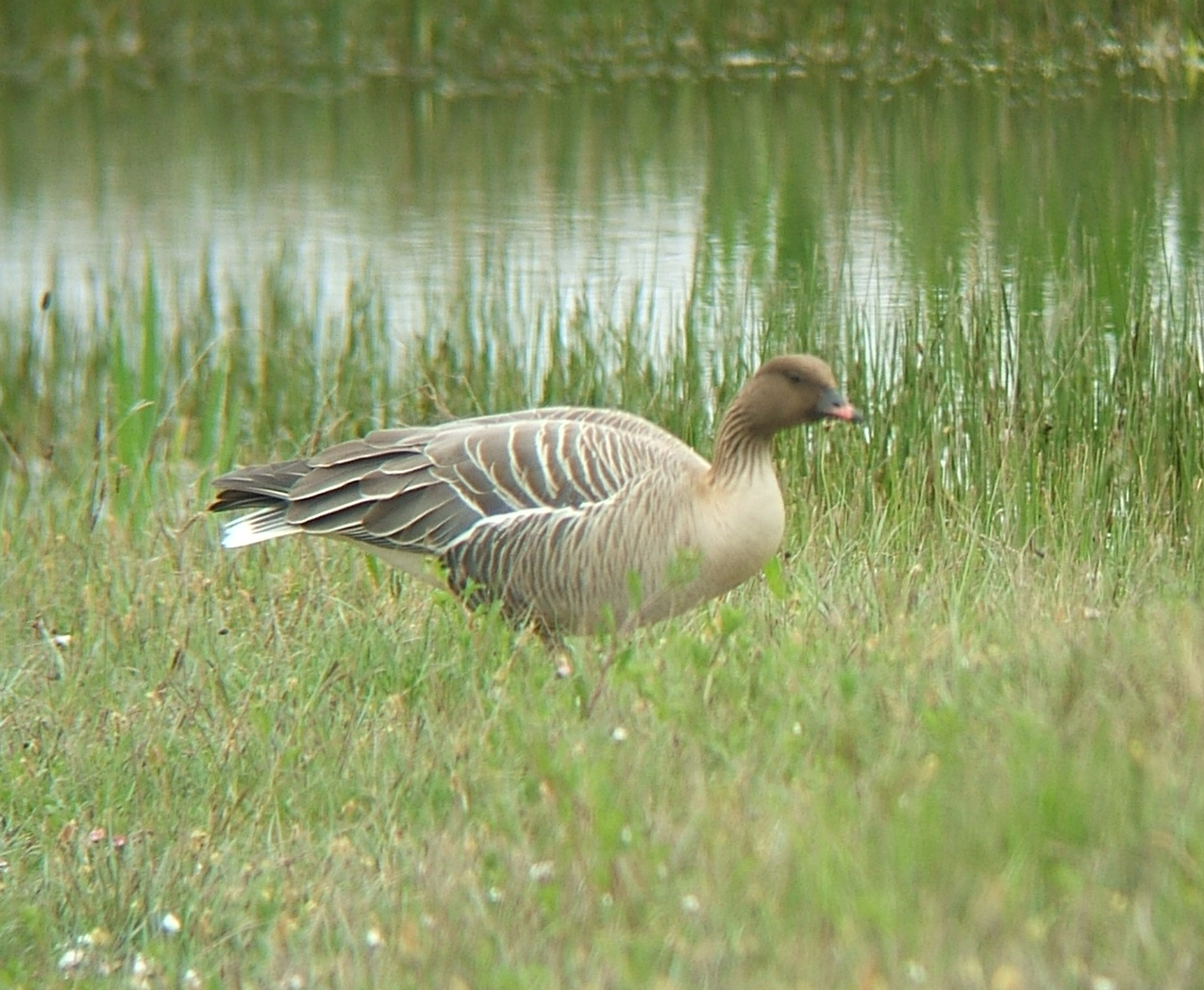- Pink-footed Goose
Taxobox
name = Pink-footed Goose
status = LC | status_system = IUCN3.1

image_width = 240px
regnum =Animal ia
phylum = Chordata
classis = Aves
ordo =Anseriformes
familia =Anatidae
genus = "Anser"
species = "A. brachyrhynchus"
binomial = "Anser brachyrhynchus"
binomial_authority = Baillon,1834 The Pink-footed Goose ("Anser brachyrhynchus") is a
goose which breeds in easternGreenland ,Iceland andSvalbard . It is migratory, wintering in northwest Europe, especiallyGreat Britain , theNetherlands , and westernDenmark . The name is often abbreviated in colloquial usage to Pinkfoot (plural Pinkfeet).It is a medium-sized goose, 60–75 cm long, the wingspan 135–170 cm, and weighing 1.8–3.3 kg. It has a short bill, bright pink in the middle with a black base and tip, and pink feet. The body is mid grey-brown, the head and neck a richer, darker brown, the rump and vent white, and the tail grey with a broad white tip. The upper wing-coverts are of a somewhat similar pale bluish-grey as in the
Greylag Goose , and the flight feathers blackish-grey. The species is most closely related to theBean Goose "Anser fabalis" (having even been treated as asubspecies of it at times in the past), sharing a similar black-and-coloured pattern bill, but differing in having pink on the bill and legs where the Bean Goose is orange, and in the paler, greyer plumage tones. It is similar in size to the small "rossicus" subspecies of Bean Goose, but distinctly smaller than the nominate subspecies "fabalis". It produces a medley of high-pitched honking calls, being particularly vocal in flight, with large skeins being almost deafening.Cramp, S. (1977). "The Birds of the Western Palearctic". Oxford ISBN 0-19-857358-8.]Population
There are two largely discrete populations of Pink-footed Goose. The Greenland and Iceland population winter in Great Britain, while the Svalbard population winters in the Netherlands and Denmark, with small numbers also in
Norway (where it is common on migration), northernGermany , andBelgium .Populations have risen spectacularly over the last 50 years, due largely to increased protection from shooting on the wintering grounds. Numbers wintering in Great Britain have risen almost tenfold from 30,000 in 1950 to 292,000 in October 2004. The numbers wintering in Denmark and the Netherlands have also risen, with about 34,000 in 1993. The most important single breeding site, at
Þjórsárver in Iceland (holding 10,700 pairs in 1970), was only discovered in1951 , by Sir Peter Scott and his team who made an expedition to seek the breeding grounds. Within Great Britain, the most important wintering areas are inNorfolk (147,000 in 2004),Lancashire (44,000 in 2004), andAberdeenshire (primarily on autumn and spring passage). Large to huge wintering flocks graze on farmland; individual flocks can be spectacular, such as the 66,000 atLoch of Strathbeg , Aberdeenshire in early September 2003.Snow, D. W. & Perrins, C. M. (1998). "The Birds of the Western Palearctic" Concise Edition. OUP ISBN 0-19-854099-X.] Collier, M., et al., eds. (2005). "Waterbirds in the UK 2003/04". Wetland Bird Survey, BTO/WWT/RSPB/JNCC ISSN 1353-7792 ISBN 1-904870-50-3.] Banks, A., et al., eds. (2006). "Waterbirds in the UK 2004/05". Wetland Bird Survey, BTO/WWT/RSPB/JNCC ISBN 1-904870-77-5.]Ecology
Nesting is often on
cliff s close toglacier s to provide protection frommammal ian predators (mainlyArctic Fox ), also on islets in lakes. Three to six eggs are laid in early to mid May in Iceland, late May in Svalbard, with incubation lasting 26–27 days. On hatching, the goslings accompany the parents on foot to the learest lake, where they fledge after about 56 days. Southbound migration is from mid September to early October, and northbound from mid April to early May.The diet is almost entirely vegetarian. In summer, they feed on a wide range of
tundra plants, both on land and in water. In winter, they graze primarily onoilseed rape ,sugar beet ,potato , and various grasses; damage to crops can be extensive, though their grazing can also benefit particularly sugar beet and potato farmers by gleaning leaves and roots left behind after the crop is harvested, reducing the transmission of crop diseases from one year to the next.Vagrancy
Despite the proximity to the large winter numbers in Great Britain, only very small numbers occur in
Ireland andFrance . It is a rare vagrant to several other European countries and as far south asMorocco and theCanary Islands , and also to easternCanada and theUnited States (from Newfoundland south toPennsylvania ).Dickinson, M. B. et al., eds. (1999). "Field Guide to the Birds of North America". National Geographic ISBN 0-7922-7451-2.]The Pink-footed Goose is one of the species to which the "Agreement on the Conservation of African-Eurasian Migratory Waterbirds" (
AEWA ) applies.References
* Database entry includes justification for why this species is of least concernExternal links
* [http://www.rspb.org.uk/wildlife/birdguide/name/p/pinkfootedgoose/index.asp RSPB A to Z of UK Birds]
* [http://ibc.hbw.com/ibc/phtml/especie.phtml?idEspecie=422 Pink-footed Goose videos at the Internet Bird Collection]
Wikimedia Foundation. 2010.
